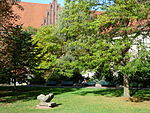Games Academy
German school stubsVideo game universitiesVocational schools in Germany
The Games Academy is the oldest German and European school dedicated to the development of video games. Besides QANTM and Supinfogame, it is one of the few institutions in Europe that are entirely focused on video game development. The Games Academy is a privately held vocational school, founded in 2000 by Thomas Dlugaiczyk in Berlin. In 2007, a second establishment was opened in Frankfurt am Main. In autumn 2019, at the world's largest games fair, Gamescom, the Games Academy and the Mediadesign Hochschule (MD.H) announced their merger. In this context, there was a change in the managing director; since 2020, Martin Adam has been in charge of the Games Academy.
Excerpt from the Wikipedia article Games Academy (License: CC BY-SA 3.0, Authors).Games Academy
Rungestraße, Berlin Mitte
Geographical coordinates (GPS) Address Nearby Places Show on map
Geographical coordinates (GPS)
| Latitude | Longitude |
|---|---|
| N 52.5124 ° | E 13.4196 ° |
Address
Rungestraße 20
10179 Berlin, Mitte
Germany
Open on Google Maps










